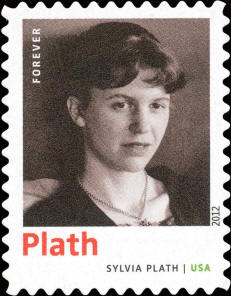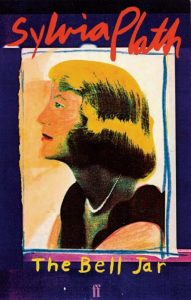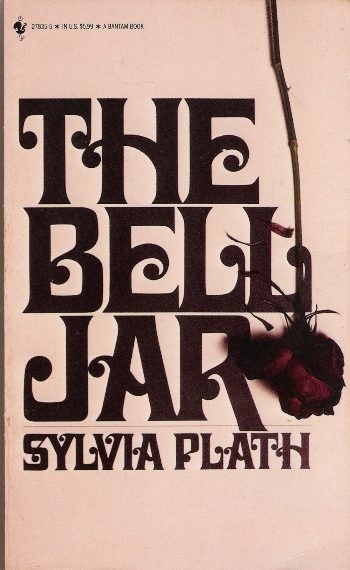The Bell Jar – Sylvia Plath – 1963

Reviewed by: Lareina Date: 3 October 2003
Sylvia Plath’s only novel The Bell Jar is the gruesomely fascinating and largely autobiographical account of an outwardly bright young woman’s descent into mental discord in 1950s New England, including her serious flirt with suicide and her subsequent treatment and mistreatment in a world of madness and asylums. This novel is divided into three parts, Esther Greenwood’s month-long visit to NYC where she works a disillusioning summer job at a twenty-something’s fashion magazine, the series of disappointing events that lead up to her suicide attempt upon her return home and, finally, her encounters with two very different mental institutions during her struggle to gain re-entry into the world.
A straight-A scholarship student, Esther lands a month-long internship at “Ladies’ Day” Magazine in NYC, where she struggles to keep up a glamorous lifestyle of tottering around the city’s expansive avenues on high heels, lunching on caviar with local celebrities, and making occasional appearances at film premieres and book signings. Amidst the frivolity and constructed social time, Esther gradually pushes away evidence of her remarkable achievements, resenting her elegant clothes, her limited social circles (the impossibly geeky medical school boyfriend, the wide-eyed, wholesome classmates) and starts to look at her life with disgust. Disenchanted, Esther returns home to find that she has been rejected from the prestigious summer writing program she had been hoping for and slowly begins sealing herself tight in a jar full of indifference to all that formerly interested her, isolating herself from her college friends and all but ignoring her mother. Her disinterested state gradually gives way to a full abandonment and of even physical needs. She stops eating; she can’t sleep. Pushed by her worried family into the doorway of the psychiatrist’s office, the first steps toward her “cure” begin with electroshock therapy. Instead, this brutal method of jolting her mind back into proper working order backfires, and Esther becomes more preoccupied than ever with the idea of death. Her foiled attempt at an overdose in hiding lands her a bed in the local hospital’s poorly-run psychiatric ward. Thanks to the strange benevolence of her literary mentor, Esther is rescued from this institution and placed in one more luxuriant where she begins her slow ascent into recovery and where she is “patched, re-treaded, and approved for the road.”
Aside from the occasional, obvious clues to her deteriorating mental state such as her abandonment of certain daily activities (ceasing to eat, sleep, bathe, etc.) and her suicide attempt (crawling into a crevice in her own cellar clutching a bottle of sleeping pills and a glassful of water), Esther is described by Plath as basically a “normal” girl perfectly capable of self-articulation. Of course, readers are aware that she is on the verge of a nervous breakdown; nevertheless, Plath recounts this episode in her life with unexpected lucidity and acerbic humour. And what great humour! Plath’s style is of consistent self-deprecation worthy of rivalling the blackest dark comedy. Her employment of sensory references gives imagery so precise that even those of us who have never experienced a depressed episode (those lucky few) are able to grasp immediately her discouragement, her wry isolation. The Bell Jar is filled with telling descriptions (like this of the fig tree) that walk the line between precision and inanity.
Moved by the story of the fig tree in a book given to her by Ladies’ Day, she transformed the image of a beautiful tree bursting with fruit into a symbol of the imprecision of her life’s path.
“From the tip of every branch, like a fat purple fig, a wonderful future beckoned and winked. One fig was a husband and a happy home and children, and another fig was a famous poet and another fig was a brilliant professor … and anther fig was Europe and Africa and South America … and beyond and above these figs were many more figs I couldn’t quite make out. I saw myself sitting in the crotch of this fig-tree, starving to death because I couldn’t make up my mind which of the figs I would choose. I wanted each and every one of them, but choosing one meant losing all the rest, and, as I sat there, unable to decide, the figs began to wrinkle and go black, and, one by one, they plopped to the ground at my feet.”
Through this description and other examples, we see Esther creating a universe of hypotheses until she loses her foothold and starts to topple backwards.
This novel provides a rare chronicle of the stigma and treatment of mental illness during an era of prim facades barricading what would otherwise be considered as untidy eruptions of grey matter. Winning instant trips to insane asylums and freely receiving electroshock treatments is all but a thing of the past as mental health moves toward community-based care and as many researchers shun shock treatments, admonishing them as barbaric and of scarce benefit to the patient. Other themes Plath explores are that of la condition féminine: a young woman’s sexual awakening in 1950s America as well as the unmistakable misogyny in her encounters with the opposite sex.
For those of you who have read Susanna Kasen’s account of her struggle with mental illness or have the seen the ensuing and interestingly adapted film, “Girl, Interrupted,” both Plath and Kaysen describe events that occurred during their stay at the infamous McLean Hospital, a private psychiatric centre tucked away in the peaceful Boston suburbs of Belmont, MA.



The Simpsons and The Bell Jar: In the episode titled “How The Test Was Won” (Season 20, Episode 11, 2009) Lisa is seen reading The Bell Jar.


















